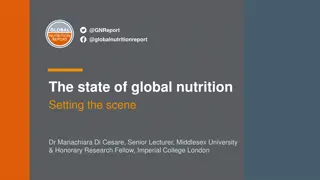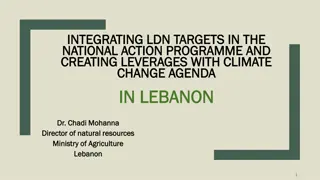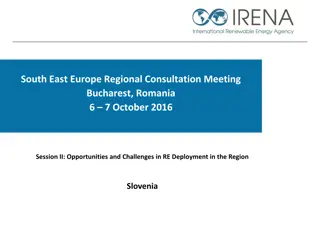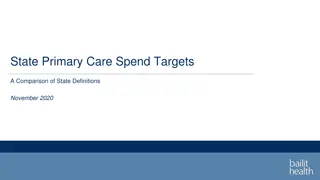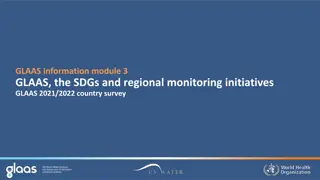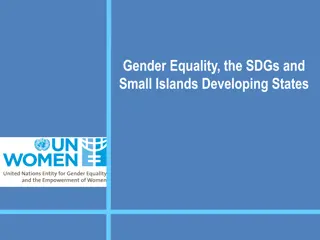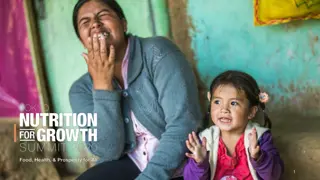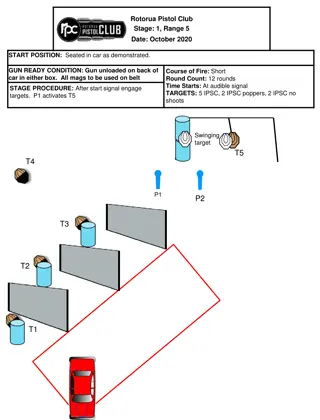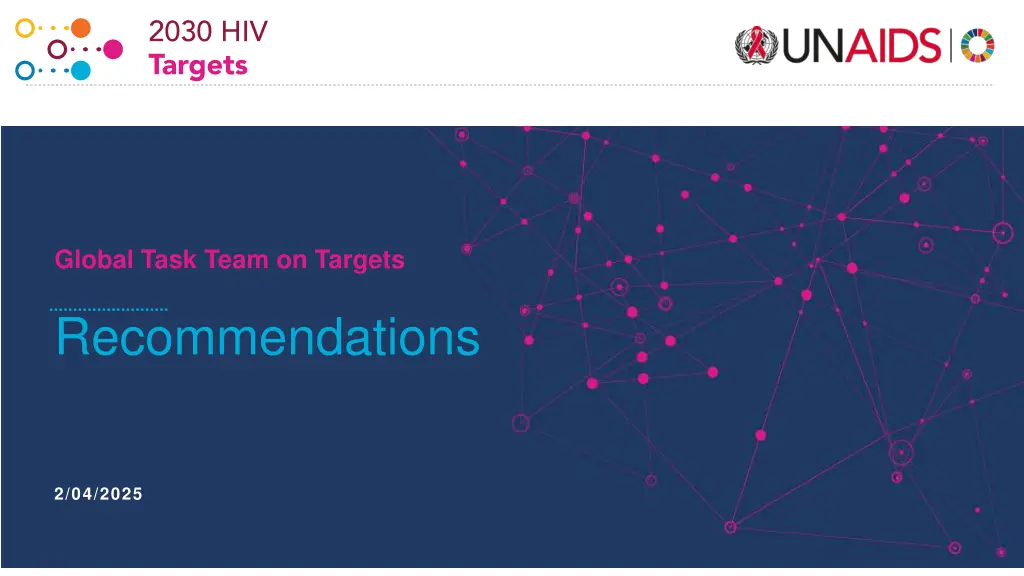
Global HIV Targets for 2030: Integration, Sustainability, and Equality
Explore the importance of global targets for HIV, focusing on integration, sustainability, and reducing inequalities. The recommended targets aim to ensure quality treatment and care, scale-up prevention options, end stigma, uphold human rights, ensure community leadership, integrate HIV systems, and secure sustainable financing. Learn about the 16 top-line targets and 50 second-tier targets to be achieved by 2030 to combat HIV effectively. Get insights from the Global Task Team's recommendations for setting 2030 HIV targets and how they align with the global health agenda.
Download Presentation

Please find below an Image/Link to download the presentation.
The content on the website is provided AS IS for your information and personal use only. It may not be sold, licensed, or shared on other websites without obtaining consent from the author. If you encounter any issues during the download, it is possible that the publisher has removed the file from their server.
You are allowed to download the files provided on this website for personal or commercial use, subject to the condition that they are used lawfully. All files are the property of their respective owners.
The content on the website is provided AS IS for your information and personal use only. It may not be sold, licensed, or shared on other websites without obtaining consent from the author.
E N D
Presentation Transcript
Global Task Team on Targets Recommendations 2/04/2025
UNAIDS Global Accountability System for HIV Routine Monitoringof Country Progress Against Targets Set 2030 Global AIDS Targets 2026 HLM and political declaration, country NSPs Develop 2026- 2031 Global AIDS Strategy
Why do we need global targets? Generate commitment and action in all countries of the world and among all stakeholders Ensure continuity with the existing Global AIDS Strategy 2021 2026 where evidence remains relevant and existing 2025 targets have not been achieved Define the highest priorities for the HIV response and simplify accountability by reducing the number of targets as compared with the set of targets for 2025. Define a path towards a more integrated effort to achieve the goal of ending AIDS alongside other relevant SDGs and global health targets such as maternal and child health (MCH), sexual and reproductive health (SRH), tuberculosis and other communicable diseases, non-communicable diseases (NCDs), cervical cancer and education And to ensure sustainability of the HIV response until 2030 and beyond
Whats new in the 2030 Global Task Team recommended targets? Focus on integration and sustainability, while reducing inequalities. 16 topline targets supported by 50 second tier targets The targets are grouped into 6 priority areas that aim to: 1. Ensure available, accessible, acceptable and quality HIV treatment and care living with HIV 2. Scale-up HIV prevention options HIV prevention options that brings together biomedical, structural, community and behavioural interventions 3. End stigma and discrimination stigma and discrimination and uphold human rights and gender equality in the HIV response 4. Ensure community leadership community leadership in the HIV response 5. Integrate HIV systems Integrate HIV systems, services and other interventions with primary health care, broader health and other services, systems and sectors for effective people-centred and sustainable HIV response(s) 6. Ensure sustainable financing sustainable financing for a people-centred national and global HIV response HIV treatment and care for people
16 topline targets to reach by 2030 A further 50 second tier targets indicate what is needed to achieve the topline targets. See summary report of the Global Task Team on UNAIDS website. Source Source: Recommendations of the Global Task Team for Setting 2030 HIV Targets, 2025, UNAIDS
HIV targets to achieve the 2030 goals 90% 90% Prevention options (PrEP, PEP, condoms, NSP, OAT) are used used by people in need of prevention 80% Condom use with a non-regular partner Preventing new HIV infections 95% 95% People-centred HIV prevention programmes reach reach adolescent girls and young women, adult women, young boys and men, and key populations in need of prevention Integrating services and systems 95% of people receiving HIV prevention or treatment services also receive SRH services 90% of women living with HIV screened and treated (if diagnosed) for cervical cancer 95% People who paid and received payment for sex used condom at last sex 50% People at highest risk of acquiring HIV access and use ARV-based prevention options 95% 95% Country distribution need met prevention options (PrEP, PEP, condoms, NSPs, OAT) 90% comprehensive sexuality education for adolescents and young people need met for effective 95% of mothers and infants receive HIV services that are integrated with prevention of vertical transmission of syphilis and hepatitis B 80% of people living with HIV are screened for NCDs (hypertension, diabetes) 95% Safe injecting equipment for people who inject drugs; 50% OAT for people who are opioid dependent By 2030, reduce new HIV infections by 90% from 2010 and incremental 5% decline per year after 2030 90% of all people living with HIV have suppressed viral loads 90% of people living with HIV screened for depression Lifting barriers of stigma and gender inequalities and ensuring human rights <10% <10% Punitive laws and policy environments that restrict access to services for key populations and people living with HIV by health providers and general population behaviours and provide mechanisms for redress together with communities 90% of key populations are screened for syphilis 90% of people living with HIV tested for hepatitis B and C 80% 80% HIV prevention options delivered by community-led organizations <10% <10% Stigma and discrimination against people living with HIV and key populations <10% <10% Gender inequality and violence against women, girls, PLHIV and key populations <10% Coercion and abuse in sexual and reproductive health services among women LWHIV 90% of countries have removed regulatory barriers for community- led organizations 90% of countries use community-led monitoring for national programme reviews Reduce AIDS- related deaths by 90% from 2010 60% 60% Societal enabler programmes delivered by community-led organizations <10% Arrests due to key population identity or 30% 30% Testing and supportive treatment services provided by community-led organizations Resourcing the HIV response Sustainability of HIV response after 2030 US$ xxx billion mobilized for HIV investments for low-and middle-income countries Increase percentage of HIV funding that is domestic Providing treatment and care for people living with HIV 95% 95% People living with HIV know their status for advanced HIV disease 95% People living with HIV screened 95% of HIV-exposed children tested at 2 months and after cessation of breastfeeding Mobilize resources for societal enabler interventions Mobilize resources for HIV prevention Price equity for drugs and diagnostics across all countries Reduce out-of-pocket expenses 90% Reduction in TB-related deaths among people living with HIV 95% 95% People living with HIV who know their status receive treatment 95% of pregnant women attend antenatal care and are screened or tested for HIV Resources allocated to communities from national and international sources 95% Preventive therapy for TB for people living with HIV, incl. children 95% 95% People living with HIV who are on treatment have suppressed viral loads 90% of services for HIV and TB care are integrated
Overarching 2030 targets Target Data source Previous target A 90% reduction in new HIV infections between 2010 and 2030 and a continued reduction of 5% per year post-2030. UNAIDS epidemiological estimates 2025 target (adjusted) A 90% reduction in AIDS- related deaths since 2010. UNAIDS epidemiological estimates 2025 target [1] 2025 targets are the existing 2025 targets that are proposed to be extended to 2030 as they have not been achieved and are still relevant. New are newly proposed recommendations. WHO targets are existing targets in WHO strategies and frameworks that are being adopted here as priority for the HIV response and would be monitored only once against both programmes.
Area 1. Ensure available, accessible, acceptable and quality HIV treatment and care for people living with HIV. Target Data source Previous target The 16 topline The 16 topline targets are targets are shaded in shaded in colour 1 GAM 2.1, 1.4. Programme data plus epidemiological estimates. For key populations (KPs): integrated biological and behavioural surveillance (IBBS). 2025 target 95% of people who are living with HIV know their HIV status. colour 2 GAM 2.2, 2.6. Programme data plus epidemiological estimates. For key populations: IBBS. 2025 target 95% of people living with HIV who know their status are on treatment. 3 GAM 2.3. Programme data plus epidemiological estimates. 2025 target 95% of people living with HIV on treatment have a suppressed viral load. 4 95% of people newly diagnosed with HIV and people reinitiating antiretroviral therapy (ART) are screened for advanced HIV disease (AHD) as measured by CD4 count or WHO staging when CD4 is not available. Programme data. New 5 30% of HIV testing and supportive services related to care and treatment are delivered by community-led organizations, including key population led and women-led organizations. Advisory group on monitoring these targets working on measurement sources and methods. Currently, policy data are used as proxy measures. 2025 target [1]Disaggregations may include, as appropriate: For key population groups (sex workers, gay men and other men who have sex with men, people who inject drugs, people in prisons and other closed settings and transgender people), pregnant women, breastfeeding women and core age groups (i.e. children younger than 15, young adults 15 24, adults 15 49 and adults 50+). [2]Indicators and questions for monitoring progress on the 2021 Political Declaration on HIV and AIDS Global AIDS Monitoring 2025. [3] Global tuberculosis programme. Geneva: WHO; 2024. Global Tuberculosis Programme. 6 95% of HIV-exposed children are tested by two months of age. GAM 3.2. Programme data plus epidemiological estimates. 2025 target 7 95% of HIV-exposed infants and children are tested after cessation of breastfeeding. Programme data plus epidemiological estimates. 2025 target 8 95% of pregnant women receive antenatal care and know their HIV status. GAM 3.1. Programme data plus epidemiological estimates. 2025 target (reworded) 9 90% of people living with HIV entering care through either HIV or TB services receive testing (and treatment if needed) for the other disease. Programme data 2025 target (reworded) 10 95% of people living with HIV have received preventive therapy for TB. Programme data Existing WHO target 11 90% reduction in TB-related deaths among people living with HIV (compared to 2010). WHO estimates 2025 target
Area 2. Scale-up HIV prevention options that bring together biomedical, structural, and behavioural interventions. Target 90% of people in need of prevention use appropriate, prioritized, person-centred and effective prevention options (pre-exposure prophylaxis (PrEP), post-exposure prophylaxis (PEP), condoms, needle/syringe programmes (NSPs), opioid agonist therapy (OAT) (topline). Data source Population-based surveys Previous target 2025 target 1 2 80% of people use a condom at last sex with a non-regular partner. GAM 1.14. Population-based surveys. New 3 50% of people at high risk of acquiring HIV (including key populations) use effective, ARV-based, prevention options: oral PrEP, long-acting PrEP, PEP (target levels in line with epidemiology and people's choices). Programme records. New 4 5 95% of sex workers and their clients used a condom at last paid sex. 95% of people who inject drugs used safe injecting equipment during their last injection. IBBS, population-based surveys. GAM 1.8. IBBS. New New [1] This target is closely related to the target that 95% of people receiving treatment are virally suppressed. However, it is measured among all people living with HIV and recognizes the importance of population-level viral suppression and its contribution to preventing new HIV infections. It is also more ambitious than the 95 95 95 targets, which would lead to 86% of people living with HIV having a suppressed viral load, reflecting the important need for countries to be more ambitious with the testing and treatment programmes. 6 50% use of opioid agonist maintenance treatment among people who inject opioids. GAM 1.10. Programme data, IBBS. 2025 target 7 95% of adolescent girls and young women, adult women, pregnant and breastfeeding women, and adolescent boys and men, effectively reached with people-centred HIV prevention programmes (HIV prevention related contact with health services, (including SRH quality services), community outreach, virtual interventions, schools or other providers). Population-based surveys or programme data. New 8 90% of schools provide life skills-based HIV and sexuality education. Annual School Census questionnaire or the UNESCO Institute for Statistics (UIS) Annual Survey of Formal Education questionnaire. GAM 1.6, 1.7.Programme data, IBBS. 2025 target 9 95% of key populations effectively reached with people-centred HIV prevention programmes. 2025 target 10 11 12 13 14 95% of the estimated need for condoms is available and distributed. 95% of the estimated need for PrEP is available and distributed. 95% of the estimated need for PEP is available and distributed. 95% of the estimated need for sterile syringes is available and distributed. 80% of people-centred HIV prevention programmes for key populations to be delivered by community-led organizations. Work is ongoing on measurement Programme data versus needs estimates. New Programme data versus needs estimates. New Programme data versus needs estimates. New Programme data versus needs estimates. New 2025 target sources and methods. Policy data on the operating environment for community-led service delivery are being used as proxy measures. GAM 2.3.Programme data plus epidemiological estimates. 15 90% of all people living with HIV are virally suppressed by 2030, increasing to 95% by 2040. New
Area 3. Integrate HIV services into primary health care (PHC), broader health systems and other sectors Target Data source Previous target 1 To be determined. 2025 target (reworded). 95% of people who are receiving HIV prevention or treatment services also receive sexual and reproductive health services they need (including for STIs). To be determined. 2025 target 2 95% of pregnant women living with HIV and their newborns receive maternal and newborn care that integrates or links to comprehensive HIV services, including for prevention of the triple vertical transmission of HIV and hepatitis B virus and treatment of syphilis. 3 90% of women living with HIV screened for cervical cancer at least once in the last five years. Programme data. New 4 90% of women living with HIV identified with cervical disease are treated and 90% of women with precancer are treated. GAM 7.10, 7.11. Programme data. New 5 80% of people living with HIV in need receive screening for hypertension and diabetes. Programme data. Aligned with WHO's 2030 target for diabetes. 6 90% of people living with HIV in HIV care receive screening for depression. Programme data. New 7 90% of gay men and other men who have sex with men and sex workers are screened for syphilis. GAM 7.3. IBBS or programme data. 2025 target (revised). 8 90% of people living with HIV tested for hepatitis C. Programme data. Existing 2030 WHO target for Hep C 9 90% of people living with hepatitis B diagnosed Programme data plus biomarker surveys or epidemiological estimates. Aligned with the WHO target for Hep B. [1] First-ever global coverage targets for diabetes adopted at the 75th World Health Assembly. Geneva: WHO; 28 May 2022. First-ever global coverage targets for diabetes adopted at the 75th World Health Assembly [2] IBBS: Integrated Biological and Behavioral Surveillance. [3] Global HIV, hepatitis and STIs programmes. Geneva: WHO; 2024; p. 62. [4] Global health sector strategies on, respectively, HIV, viral hepatitis and sexually transmitted infections for the period 2022 2030. Geneva: WHO; 2024; p. 62. Global health sector strategies on HIV, viral hepatitis and sexually transmitted infections for the period 2022-2030
Area 4. End stigma and discrimination and uphold human rights and gender equality in the HIV response (1/2) Target Less than 10% of countries have punitive legal and policy environments that deny or limit access to services (topline target). Less than 10% of people living with HIV and people from key populations lack access to legal services. Data source Topline target not measured; sub- targets measured. NCPI. Previous target 2025 target 1 2 2025 target 3 Less than 10% of countries criminalize sex work, possession of small amounts of drugs, same-sex sexual behaviour and HIV transmission, exposure, or non-disclosure. Less than 10% of countries lack mechanisms for people living with HIV and people from key populations to report abuse and discrimination and seek redress. Over 90% of people living with HIV who experienced rights abuses have sought redress. NCPI plus national legal document reviews. NCPI. 2025 target 4 2025 target 5 GAM 6.7. People living with HIV Stigma Index 2.0. IBBS. 2025 target 6 Less than 10% of key populations experienced harassment, arrest, detention, or incarceration in the past year at the individual level. Less than 10% of people living with HIV and key populations (gay men and other men who have sex with men, sex workers, transgender and people who inject drugs) experience stigma and discrimination (topline target). New 7 Topline target not measured, sub- targets measured. 2025 target 8 Less than 10% of the general population reports discriminatory attitudes towards people living with HIV. GAM 6.1. Population-based surveys. GAM 6.8. Health facility survey. GAM 6.9. Health facility survey. GAM 6.10. Police survey. GAM 6.5. IBBS. GAM 6.3, 6.4.People living with HIV Stigma Index 2.0. GAM 6.2. People living with HIV Stigma Index 2.0. 2025 target 9 Less than 10% of health workers report negative attitudes towards people living with HIV. 2025 target 10 Less than 10% of health workers report negative attitudes towards key populations. 2025 target 11 Less than 10% of law enforcement officers report negative attitudes towards key populations. 2025 target 12 Less than 10% of people from key populations experience stigma and discrimination. 2025 target 13 Less than 10% of people living with HIV experience stigma and discrimination in healthcare and community settings. 2025 target 14 Less than 10% of people living with HIV report internalized stigma. 2025 target [1] National Commitments and Policy Instrument https://indicatorregistry.unaids.org/sites/default/files/2024-global-aids- monitoring_en.pdf
Area 4. End stigma and discrimination and uphold human rights and gender equality in the HIV response (2/2) 15 Topline target not measured, sub- targets measured. SDG 5.2.1.Population-based surveys. 2025 target Less than 10% of women, girls, people living with HIV and key populations experience gender inequality and violence (topline target). Less than 10% of women and girls experience psychological, physical, or sexual violence from an intimate partner. 16 2025 target 17 Less than 10% of people from key populations (gay men and other men who have sex with men, sex workers, transgender and people who inject drugs) experience physical or sexual violence. IBBS. 2025 target 18 Less than 10% of people support inequitable gender norms. GAM 4.2. Population-based surveys. GAM 4.3. Facility checklist. No source available. People living with HIV Stigma Index 2.0. 2025 target (GAM 4.2) 2025 target (GAM 4.3) 2025 target New 19 More than 90% of HIV services are gender responsive. 20 21 Less than 10% of people living with HIV experience physical or sexual violence. Less than 10% of women living with HIV experience coercion, mistreatment, or abuse in sexual and reproductive health services.
Area 5. Ensure community leadership in the HIV response [to be read in conjunction with areas 1 and 2] Target Data source Previous target 1 Work is ongoing on measurement sources and methods. Policy data on the operating environment for community-led service delivery are being used as proxy measures. 2025 target 60% of programmes that support achievement of the societal enablers to be delivered by community-led organizations, including key population-led and women- led organizations. 2 90% of countries remove regulatory barriers for HIV-related community-led organizations (registration, eligibility, etc.). To be determined New 3 90% of countries incorporate community-led monitoring data into national decision-making processes to strengthen accountability in HIV and TB programmes. To be determined New
Area 6. Ensure sustainable financing for a people-centered national and global HIV response Target Data source Previous target 1 2025 target Countries commit to sustaining the HIV response by progressively increasing domestic funding; low-income countries reach 30%, low and middle-income countries reach 50%, and upper and middle- income countries reach 95% of their total funding for HIV. National AIDS spending assessments (NASAs), national health accounts (NHA) and GAM 8.3. 2 Countries monitor and report on resources allocated to community-led and other civil society organizations to deliver: community-led monitoring (CLM); programmes addressing societal enablers; and HIV prevention, testing and supportive services to treatment and care from both national governments and international sources GAM 8.3 NASAs with an enhanced focus on resource tracking for community-led responses, as introduced in GAM in 2024 and health accounts. New 3 GAM 8.3. NHA-HIV sub accounts that report OOPEs and NASAs. Aligned with WHO targets A reduction in out-of-pocket expenditures(OOPEs)14, through national policy instruments, in accordance with WHO Universal Health Coverage guidelines. [1] SDG Target 3.8.2. New York: United Nations; SDG 3.8.2 Catastrophic health spending (and related indicators) [2] WHO UHC technical brief. Geneva: WHO; 2017. Equitable access to medicines.indd (accessed: 17 January 2025): https://iris.who.int/bit stream/handle/10665 /258914/Equitable_a ccess_medicines.pdf ?sequence=1 4 GAM 8.3 Donor reporting and NASA. 2025 target MEASURED AT GLOBAL LEVEL Mobilize HIV Investments of XX billion annually in LMICs by 2030. (Exact number being estimated). 5 MEASURED AT GLOBAL LEVEL Mobilize an average of XX% of the required resources for HIV prevention in low- and middle-income countries tailored to the unique needs of each country. GAM 8.3. NASA 2025 target 6 MEASURED AT GLOBAL LEVEL Mobilize an average of XX% of the required resources for societal enablers in low- and middle-income countries, tailored to the specific needs of each country and leveraging the latest opportunities. GAM 8.3, NASA. New 7 GAM 8.2 Existing WHO target MEASURED AT GLOBAL LEVEL All countries have access to equitable pricing for diagnostics and therapeutics.
Monitoring progress towards the targets Progress towards the targets will be monitored through annual country reporting on the Global AIDS Monitoring (GAM) framework The GAM framework consists of: -Quantitative indicators, including on financing -Questionnaire on laws and policies -Part A: completed by national authorities -Part B: completed by communities -Narrative summaries The content and structure of the GAM framework will be updated to align with global targets and commitments adopted by countries Data from previous GAM reporting are available at https://aidsinfo.unaids.org/ and annual Global AIDS Update reports
Data sources required for monitoring progress towards recommended targets Data from the following sources will be needed: Integrated bio- behavioural surveillance HIV Stigma Index 2.0 studies Size estimates of key populations Population- based surveys epidemiological estimates Surveys among police, healthcare workers Needs estimates of prevention services Questionnaire on laws and policies Resource tracking Service delivery data
Linking the 2030 Targets and the Strategy The Targets provide the direction of travel: the what The Strategy will determine thestrategic actions needed to reach the targets: the how The strategy should focus on how we achieve the topline targets and should consider the 50 second-tier targets to inform what programmes will help us achieve these targets See the summary document on UNAIDS website for the list of targets See the Glion meeting report for some of the reasoning behind the selection of targets Estimates of the impact of reaching the 2030 targets and the potential price tag will be available in the coming weeks Working with countries to model the impact of different funding scenarios at country level





